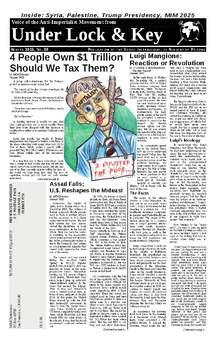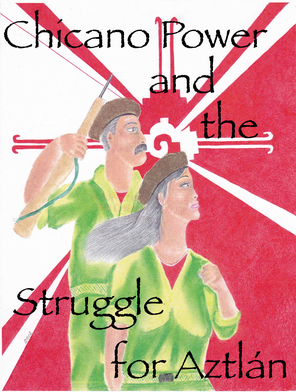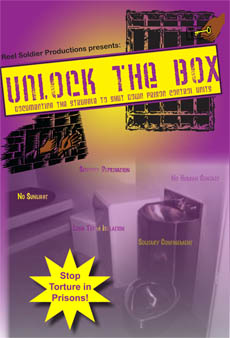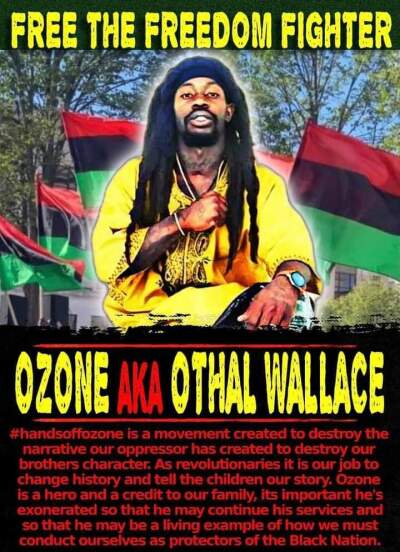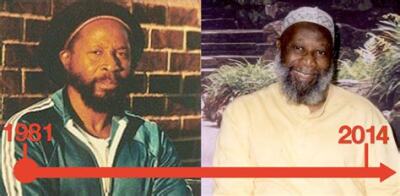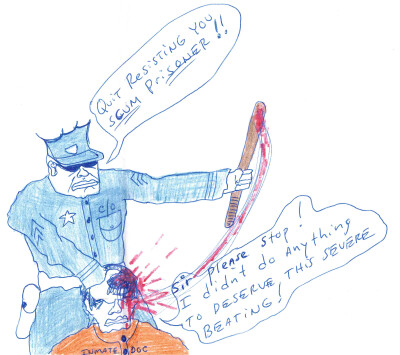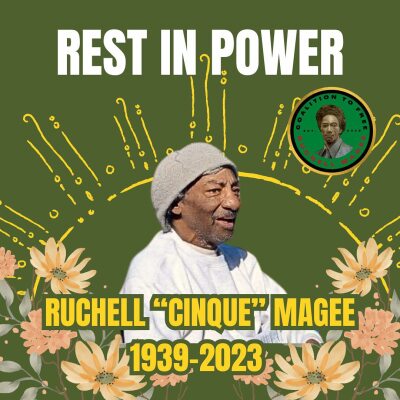
Book Review: Tip of the Spear
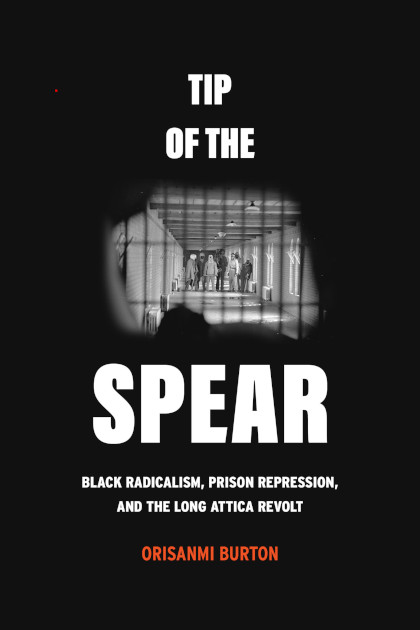
Orisanmi Burton (Author)
University of California Press
October 2023
“without understanding carceral spaces as zones of undeclared domestic war, zones that are inextricably linked to imperial and officially acknowledged wars abroad, we cannot fully understand how and why the U.S. became the global leader of incarceration that it is today.” (1)
Tip of the Spear is the story of the organization and flourishing of resistance to American imperialism as it developed in the New York state prison system in the 1960s and 1970s, including the time well before the four days of Attica in 1971. Professor of anthropology Orisanmi Burton does many things in this book, a lot of which we’ll only be able to mention briefly or not at all, but MIM(Prisons) has already sent out many copies of this book and is prepared to send out many more to enable further study and discussion of Burton’s very worthy research and ideas.
We are asking our readers to send their own feedback on this book, to write up their own local histories or stories applying the framework below, and to popularize this understanding of U.$. prisons as part of the imperialist war on the oppressed peoples of the world that we must unite against.
Prisons are War
Burton begins his investigation with George Jackson’s observation that Black people “were defeated in a war and are now captives, slaves or actually that we inherited a neoslave existence.” (2) Prison conditions don’t originate in the law or in ideas but in the historical fact of defeat in a war that still continues.
But what kind of war is it? One side surrounds the other and forces it to submit daily, the way that an army laying siege to a city tries to wear down the resistance of the population. These sieges include not just starving prisoners of food but of social life, education, and culture. In maintaining its rule the state uses the tools of counterinsurgency to split the revolutionary ranks, co-opt the cause and re-establish its rule on a more secure level. On the other side, the prisoners have themselves, their ability to unite and organize in secret, and their willingness to sacrifice for the cause – the attributes of a guerrilla army. (3)
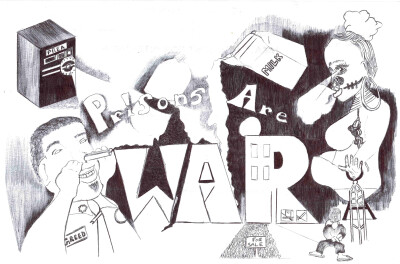
Burton spends an entire chapter, “Hidden War,” laying out the strategies the state pursued when its naked brutality failed to prevent prisoner organization and rebellion. After the smoke cleared at Attica and wardens, politicians and prison academics had a chance to catch their breath, they settled on four strategies to prevent another Attica from happening: (4)
One, prisons were expanded across the state, so that density was reduced and prisoner organizing could be more effectively disrupted. If a prisoner emerged as a leader, they could be sent to any number of hellholes upstate surrounded by new people and have to start the process all over again. The longer and more intense the game of Solitaire the state played with them, the better. We see this strategy being applied to USW comrades across the country to this day.
Prisons were also superficially humanized, the introduction of small, contingent privileges to encourage division and hierarchy among prisoners, dull the painful edge of incarceration somewhat, and dangle hope. Many prisoners saw through it, and Burton makes the point that the brief periods of rebellion had provided the only real human moments most prisoners had experienced during their time inside. For example, Attica survivor, John “Dacajeweiah” Hill described meeting a weeping prisoner in D yard during the rebellion who was looking up at the stars for the first time in 23 years. (5) Burton sums this up: “the autonomous zones created by militant action… had thus far proven the only means by which Attica’s oppressive atmosphere was substantially ameliorated.”
Diversification went hand in hand with expansion, where a wide range of prison experiences were created across the system. Prisons like Green Haven allowed prisoners to smoke weed and bring food back to their cells, and permitted activities like radical lectures from outsiders. At the same time, other prisons were going on permanent lockdowns and control units were in development.
And finally, programmification presented a way for prisoners to be kept busy, for outsiders (maybe even former critics of the prison system) to be co-opted and brought into agreement with prison officials, and provide free labor to keep the system stable by giving prisoners another small privilege to look forward to. To this day, New York, as well as California and other states, require prisoners who are not in a control unit to program.
All of this was occurring in the shadow of the fact that the state had demonstrated it would deploy indiscriminate violence, even sacrificing its own employees as it had at Attica, to restore order. The classic carrot-and-stick dynamic of counterinsurgency was operating at full force.
Before Attica: Tombs, Branch Queens, Auburn
Burton discusses Attica, but doesn’t make it the exclusive focus of his book, as it has already been written about and discussed elsewhere. He brings into the discussion prison rebellions prior to Attica that laid the groundwork, involved many of the same people, and demonstrated the character of the rebellions overall.
The first was at Tombs, or the Manhattan House of Detention, where prisoners took hostages and issued demands in the New York Times, denouncing pretrial detention that kept men in limbo for months or years, overcrowding, and racist brutality from guards. Once the demands were published, the hostages were released. Eighty corrections officers stormed the facility with blunt weapons and body armor and restored order, and after the rebellion two thirds of the prisoners were transferred elsewhere to break up organizations, like the Inmate Liberation Front, that had grown out of Tombs and supported its resistance. (6) Afterwards, the warden made improvements and took credit for them. This combination of furious outburst, violent response and conciliatory reform would repeat itself.
Next Branch Queens erupted, where the Panther 21 had recently been incarcerated. Prisoners freed them, hung a Pan-Afrikan flag out of a window, took hostages and demanded fair bail hearings be held in the prison yard or the hostages would be executed. The bail hearing actually happened and some of the prisoners who had been in prison for a year for possibly stealing something were able to walk out. The state won the battle here by promising clemency if the hostages were released, which split the prisoners and led to the end of the rebellion. Kuwasi Balagoon, who would later join the Black Liberation Army, was active in the organization of the rebellion and learned a lot from his experiences seeing the rebellion and the repression that followed after the state promised clemency. (7)
At Auburn Correctional Facility on November 4th, Black prisoners rebelled and seized hostages for eight hours. Earlier, fifteen Black prisoners had been punished and moved to solitary for calling for a day off work to celebrate Black Solidarity Day. After the restoration of order, more prisoners were shipped away and the remainder were subject to reprisals from the guards.
In each case, prisoners formed their own organizations, took control, made demands and also started building new structures to run the prison for their own benefit – even in rebellions that lasted only a few hours. After order was restored, the state took every opportunity to crush the spirits and bodies of those who had participated. All of this would repeat on a much larger scale at Attica.
Attica and Paris: Two Communes
Burton acknowledges throughout the book a tension that is familiar to many of ULK’s readers: reform versus revolution. He sees both in the prison movement of the 1960s and 1970s in New York, with some prisoners demanding bail reform and better food and others demanding an end to the system that creates prisons in the first place. But in telling the story of Attica and the revolts that preceded it he emphasizes two things: the ways reforms were demanded (not by petitions but by organized force) and the existence of demands that would have led to the end of prisons as we know them. On Attica itself, he writes that the rebellion demanded not just better food and less crowded cells but the “emergence of new modes of social life not predicated on enclosure, extraction, domination or dehumanization.” (8) In these new modes of social life, Burton identifies sexual freedom and care among prisoners emerging as a nascent challenge to traditional prison masculinity.
Attica began as a spontaneous attack on a particularly racist and brutal guard, and led to a riot all over the facility that led to the state completely losing control for four days starting on September 9th, 1971. Hostages were again taken, and demands ranging from better food to the right to learn a trade and join a union issued to the press. Prisoners began self-organizing rapidly, based on the past experiences of many Attica prisoners in previous rebellions. Roger Champen, who reluctantly became one of the rebellion’s organizers, got up on a picnic table with a seized megaphone and said “the wall surrounds us all.” Following this, the prisoners turned D Yard into an impromptu city and organized their own care and self-defense. A N.Y. State trooper watching the yard through binoculars said in disbelief “they seem to be building as much as they’re destroying.” I think we’d agree with the state trooper, at least on this. (9)
Burton’s point in this chapter is that the rebellion wasn’t an attempt (or wasn’t only an attempt) to get the state to reform itself, to grant rights to its pleading subjects, but an attempt, however short-lived, to turn the prisons into something that would be useful for human liberation: a self-governing commune built on principles of democracy and solidarity. Some of the rebels demanded transport to Africa to fight the Portuguese in the then-raging colonial wars in Mozambique and Angola, decisions were made by votes and consensus, and the social life of the commune was self-regulated without beatings, gassings and starvation.
Abolition and the Concentric Prison
Burton is a prison abolitionist, and he sees the aspirations of the Attica rebels at their best as abolitionist well before the term became popular. But he doesn’t ignore the contradictions that Attica and other prison rebellions had to work through, and acknowledges the diverse opinions of prisoners at the time, some of whom wanted to abolish prisons and some of whom wanted to see the Nixons and Rockefellers thrown into them instead. (10)
The Attica Commune of D Yard had to defend itself, and when the rebelling prisoners suspected that some prisoners were secretly working for the state, they were confined in a prison within a commune within a prison, and later killed as the state came in shooting on the 13th. There was fighting and instances of rape among the prisoners that freed themselves, and there were prisoners who didn’t want to be a part of the rebellion who were forced to. And the initial taking of the guards constitutes a use of violence and imprisonment in itself, even if the guards were treated better than they’d ever treated the prisoners.
Burton acknowledges this but doesn’t offer a tidy answer. He sees the use of violence in gaining freedom, like Fanon, to be a necessary evil which is essential to begin the process but unable to come close to finishing it. Attica, even though it barely began, provides an example of this. While violence is a necessary tool in war, it is the people organized behind the correct political line in the form of a vanguard party that ultimately is necessary to complete the transformation of class society to one without oppression.
Counter-intelligence, Reform, and Control
The final part of the book, “The War on Black Revolutionary Minds,” chronicles the attempts by the state to destroy prison revolutionaries by a variety of methods, some more successful than others, all deeply disturbing and immoral.
Some of the early methods involved direct psychological experimentation, the use of drugs, and calibrated isolation. These fell flat, because the attempts were based on “the flawed theory that people could be disassembled, tinkered with, and reprogrammed like computers.” (11) Eventually the state gave up trying to engineer radical ideas out of individual minds and settled for the solution many of our readers are familiar with: long-term isolation in control units, and a dramatically expanding prison population.
There is a lot else in this book, including many moving stories from Attica and other prison rebellion veterans that Burton interviewed, and who he openly acknowledges as the pioneering theorists and equal collaborators in his writing. Burton engages in lengthy investigations of prisoner correspondence, outside solidarity groups, twisted psychological experiments, and many other things I haven’t had the space to mention. We have received a couple responses to the book from some of you already, which the author appreciates greatly, and we’d like to facilitate more.
^Notes: 1. Burton, Orisanmi Tip of the Spear: Black Radicalism,
Prison Repression, and the Long Attica Revolt p. 19 All citations will
be of this book unless otherwise specified.
2. Jackson, Soledad
Brother, 111–12 cited in Burton p. 10
3. p. 3
4. pp. 152-180
5. Hill and Ekanawetak, Splitting the Sky, p. 20. cited in Burton,
p. 107
6. p. 29
7. p. 48
8. p. 5
9. pp. 88-91
10.
p. 95
11. p. 205^
